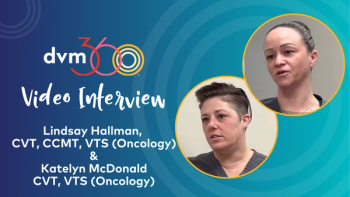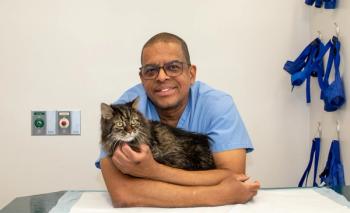Click here to listen to Martínez’s full answer, where she discusses her most rewarding experiences and challenges across general practice, emergency medicine, and her work at an animal sanctuary.
On being seen in veterinary medicine: A conversation with Melody Martínez, CVT
In this Q&A, Martínez reflects on her experiences in veterinary medicine as a person of color and on what it takes for clinics to fully recognize an underrepresented professional's "whole person."
For Melody Martínez, CVT, a career in veterinary medicine—or even the thought that such a path existed—was not in her horizon growing up. The first-generation daughter of Afro-Caribbean immigrants from the Dominican Republic, Martínez didn’t grow up with pets or seeing people who looked like her in veterinary clinics. Her path began with a single question from a coworker in a different profession. What followed was a career that has spanned general practice, emergency medicine, and work at an animal sanctuary. These years brought both rewarding experiences and what Martínez describes as “morally distressing” encounters with systemic inequities in care. Now, Martínez works as the executive director of the Multicultural Veterinary Medical Association and is the founder and consultant of Acorde Consulting, a racial equity and organizational change consultation.
In this conversation, through personal anecdotes, Martínez explores identity, belonging, and what it takes to build a more diverse profession.
This interview has been edited and condensed for clarity.
What first drew you to veterinary medicine, and how did you find your path as a technician?
Martínez: I did not grow up knowing about veterinary medicine. Unlike a lot of veterinary professionals who say, “I always knew I wanted to work with animals,” I didn't grow up with animals. I've always loved animals as a kid, [but] I didn't get my first dog until I was 14. Even then, when we would bring our dog to the vet, I never saw anyone who looked like me in the in the building or in the clinic. It never occurred to me that this could be a career path.
One of my first jobs [in college] was at an optometrist office as a medical assistant. I was looking for a different path, and it was the optician that I was working with said, “I know you love animals—have you ever considered a job in veterinary medicine?”
I [had] never considered that and so I started looking for work in that area. My first job as a client service representative [CSR] came from just that one [question].
You’re a first-generation daughter of Afro-Caribbean, working-class immigrants from the Dominican Republic. How has that shaped the way you see the veterinary profession?
Martínez: Until recently, I had not met anyone from a similar background. That tells me something about the work the profession has to do to be more inclusive—not just in general, but also [for] Latinos and Hispanic people within the profession.
My parents immigrated here in the '70s. My brothers and I were the first in our immediate family to go to college, and that first-generation working-class background had a pretty significant impact in a lot of things in my life.
One of those things was growing up with animals. My mom didn't need another mouth to feed, so getting a dog was never in the cards. She didn't grow up with dogs. She [wasn’t] looking to ensure that her kids had that that sort of relationship with animals.
I think that that alone is [one of] the barrier to understanding the opportunities within the veterinary profession, or that they exist at all.
The other piece of that is, I grew up in a predominantly White community in the US, [and in] my elementary, middle school, high school class, I would see just a handful of people of color and maybe one other person from my similar background.
My education in the US had a huge impact on my understanding of and obsession with animals because I think that, generally, Americans have a lot of them.... The obsession with pets that we see in the US, I think that was imparted on me growing up in school.
All my friends had pets, right? And we didn't. I think that...those circumstances [growing up] shaped my desire for a dog.
I remember as a kid struggling with fitting in, or feeling like it didn't fit in. And I remember always asking for a dog. I remember that there was this underlying thing—I couldn't articulate it as a child, but as I grew up, I kind of realized what it was, and it was like, We're not truly American until we have a dog, because everyone I know has a dog.
For me, that's what it meant to be American. To have made it—to fit in—is you have to have an animal in your house. You have to have an animal as a family member, right?
What are some of the most challenging experiences you’ve had in your clinical roles?
Martínez: Working in emergency medicine, I learned and did a lot that I never thought I would do as a veterinary technician. [But] the challenge in that area was noticing [the issues in] access to care—at the time, we weren't [yet] having this conversation.
I was noticing it in particular with poor communities. In particular, I would see people of color, immigrants who did not have the resources to provide emergency care for their pets to save their lives, and see that the options that they were presented with were not what we would have presented someone who walked in with money.
[The hospital] had...an angel fund to help with people who didn't have money. If those angel funds were gone by that time of the month, then the options were limited for the patient and for that family.
There was this one instance where I was [in the room] translating what the doctor was saying in Spanish [for a family]. There was a little girl, she looked a lot like me, and I was telling her what the issue was with her cat and telling this family that their options were basically to euthanize. That broke me.
There were many more incidences like that that were morally distressing and were tied to systemic inequities in vet med[icine]—in society.
How have those experiences influenced your perspective on the profession?
Ultimately, it wasn't just the access to care stuff that made me leave. It was also the inability of the of the practice I was working at to really see me as someone who provided bicultural perspectives, bilingual support, and a more unique and different perspective than the average veterinary technician who [had] that classic, traditional veterinary background.
I was trying to articulate, “I want to work to expand access to these particular communities,” [but] that language didn't exist yet.
That was really challenging for me. It was this kind of neglect or denial of the value that I bring outside of the technical skills and knowledge. [I felt like I was] in a place where my whole being [wasn’t] being valued, and the things that I [wanted] to do in the communities, the way that I [wanted] to express myself within this profession [was] not being seen...and so I left.
What brought me back was the work that MCVMA was doing and eventually getting involved with an organization in my community that improves access to care for communities and people experiencing homelessness with their pets, or who are living below the federal poverty line or experiencing extreme poverty with their pets. Once I got involved with MCVMA, I was like, I found my home in vet med.
Technician retention and recognition are ongoing challenges in veterinary medicine. What do you think practices can do to better support technicians, particularly those from multicultural communities?
Number one: pay your technicians not just a living wage, [but] a thriving [one].
[But] it's not enough to just pay us. You've got to be able to see the whole person, particularly for underrepresented people in vet med—whether it's people of color, Latine, Hispanic, Black, indigenous, queer people, disabled people. It is so important that the whole person is seen and valued, and that people are offered the opportunities to do work that really matters to them.
For some people, in particular those who are Hispanic and Latine, that includes being able to support our communities. And it's more than just [calling in someone] to interpret [or translate] when someone who speaks Spanish or has limited English comes in.
Not every Hispanic or Latine [person] speaks Spanish. Some people do but are not comfortable [with] interpreting medical information.
If they are interested, what would it look like to grow the Spanish-speaking community at that clinic? Could that person be involved in opportunities that bring that community to that clinic? [Could they help] that clinic be seen as the place where Spanish speakers, Vietnamese, Creole, Arabic speakers, go to get their pet's needs met?
I think one of the ways that we need to critically understand how to retain people of color in the profession, especially technicians, assistants, and support staff in general, is to ask ourselves: What more could they be doing? What more do they want to be doing, and how do we support that?
If there's one message you'd like veterinary professionals to take away during Hispanic Heritage Month, what would it be?
I think it's important to recognize that the person sitting before you in your clinic [or] wherever you are in vet med, may be dealing with more than just the standard challenges that we all deal with in the profession.
It’s important to recognize that to support Hispanic and Latine people in the profession, it means seeing the full person outside of their role. [It means] engaging them, offering them opportunities to do more, to grow—and noticing what other things could be impacting them. And consider, what is the role of the veterinary profession to address those potential threats, those barriers, those needs?
Newsletter
From exam room tips to practice management insights, get trusted veterinary news delivered straight to your inbox—subscribe to dvm360.







